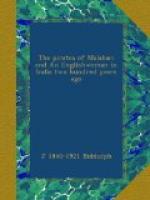The Civil War brought these courtly piracies to an end, and the decay of the Spanish power drew the more turbulent spirits of Europe and America to the Spanish main, so that for a time there was a diminution of European piracy in Indian waters. As buccaneering became more dangerous, or less lucrative, adventurers of all nations again appeared in Eastern waters, and the old trouble reappeared in an aggravated form. The Indian Red Sea fleet offered an especially tempting booty to the rovers. Lobo, a Jesuit priest, writing in the seventeenth century, tells us that so vast was the commerce of Jeddah, and so great the value of the ships trading to that place, that when, in India, it was wished to describe a thing of inestimable price, it was customary to say, ’It is of more value than a Jeddah ship.’ Every year during the winter months, Indian traders, and pilgrims for Mecca, found their way in single ships to the Red Sea. On the setting in of the monsoon, they collected at Mocha, and made their way back in a single body. All Indian trade with the Red Sea was paid for in gold and silver, so that the returning ships offered many tempting prizes to freebooters.
In 1683 John Hand, master of the Bristol, interloper, cleared his ship with papers made out for Lisbon and Brazil, and sailed for Madeira. There he called his crew together, and told them he intended to take his ship to the East Indies. Those who were unwilling were overawed, Hand being a mighty ‘pastionate’ man. He appears to have been half pirate and half trader; equally ready to attack other traders, or to trade himself in spices and drugs. On the Sumatra coast, finding the natives unwilling to do business with him, he went ashore with a pistol in his pocket to bring the ‘black dogs’ to reason. The pistol went off in his pocket and shattered his thigh, and that was the end of John Hand.
In the same year, six men, of whom four were English and two Dutch, while on passage in a native merchant’s ship from the Persian Gulf to Surat, seized the ship, killing the owner and his two wives. The lascars were thrown overboard, six being retained to work the ship. Their cruise did not last long. Making for Honore, they threw the six lascars overboard when nearing the port. The men managed to get to land, and reaching Honore, gave information of the would-be pirates to the local authorities, who seized the ship, and soon disposed of the rogues.
Three years later, two ships under English colours, mounting respectively forty-four and twenty guns, were reported to have captured vessels in the Red Sea, to the value of Rs.600,000. The Seedee of Jinjeera, who styled himself the Mogul’s Admiral, received a yearly subsidy of four lakhs for convoying the fleet, a duty that he was quite unable to perform against European desperadoes. Public opinion at Surat was at once excited against the English, and further inflamed by the Dutch and French, who were only too anxious to see a rival excluded from the trade. Sir John Child, to pacify the Governor, offered to send a man-of-war to look for the pirates; but the Dutch and French factors continued to ‘spitt their venom’ till the Governor laughed in their faces and asked why they did not join in sending vessels to look for the rogues, since the matter seemed to them so serious.




